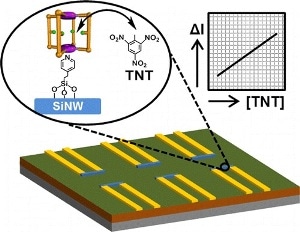Jan 18 2017
Researchers have developed a new type of nanosensor that is capable of determining both the presence and quantity of explosives such as TNT. The new technology offers a potential replacement for sniffer dogs, and could open the door to sensing applications for a variety of target analytes.
 An illustration of the MOP/SiNW-based FET system, which responds in a characteristic way in the presence of TNT molecules. (Image courtesy of Nano Letters.)
An illustration of the MOP/SiNW-based FET system, which responds in a characteristic way in the presence of TNT molecules. (Image courtesy of Nano Letters.)
TNT Cages
The nanosensors are comprised of two main components: metal-organic polyhedral (MOP) molecular cages, and silicon nanowire (SiNW)-based field effect transistors (FETs). The coordination of the two components is what allows for the sensing of 2,4,6-trinitrotoluene (TNT).
Let’s start with the MOPs. Picture a tiny chemical cage with just enough space inside to accommodate a single molecule, such as TNT. Beyond getting the size right, you also have to make sure the target molecule will match up with the cage—kind of like a puzzle piece. Researcher Louis de Smet explains:
“In the case of relatively small molecules, as with explosives, the challenge is to ensure that the cage structure is not only the right size but that it also has the right anchor points so that the molecule can click into place—thus rendering it detectable.”
MOPs are a good candidate for sensing applications because they can be tuned for different molecules. “Through variation with a large number of geometric and electronic properties of these complex cage molecules, we are able to capture the ‘explosive’ molecules we are looking for,” explained de Smet.
But trapping TNT molecules in MOP cages is only the first step. You need some way to determine if you’ve caught one—that’s where the SiNW-based FETs come into play. When there’s a local change in charge density on these devices, the current flowing through the SiNW channel is altered. The change in charge density is induced by the binding of an ion or a molecule.
Therefore, by placing several MOP cages on top of a SiNW chip, you create a system that will reliably respond to your target analyte. “The presence of [TNT molecules] causes the electrical conductance of the underlying silicon nanowires to change in a very characteristic way,” said de Smet. “We can measure this and thus confirm that we have actually found TNT molecules from an explosive.”
Done with Detection Dogs
The new nanosensor could become a replacement for current detection methods, such as color-changing chemical reactions or the use of sniffer dogs. In fact, the MOP/SiNW-FET nanosensors offer a distinct advantage over these mainly qualitative techniques. “The great thing about our method is that you can not only detect whether there are traces of TNT, but you can also determine the amount,” said de Smet.
Furthermore, by adjusting the properties of the MOPs, the sensor can be tuned to detect more than just TNT. In this way, the research offers a new method for designing and developing sensors to accommodate different target molecules.
Source: http://www.engineering.com/